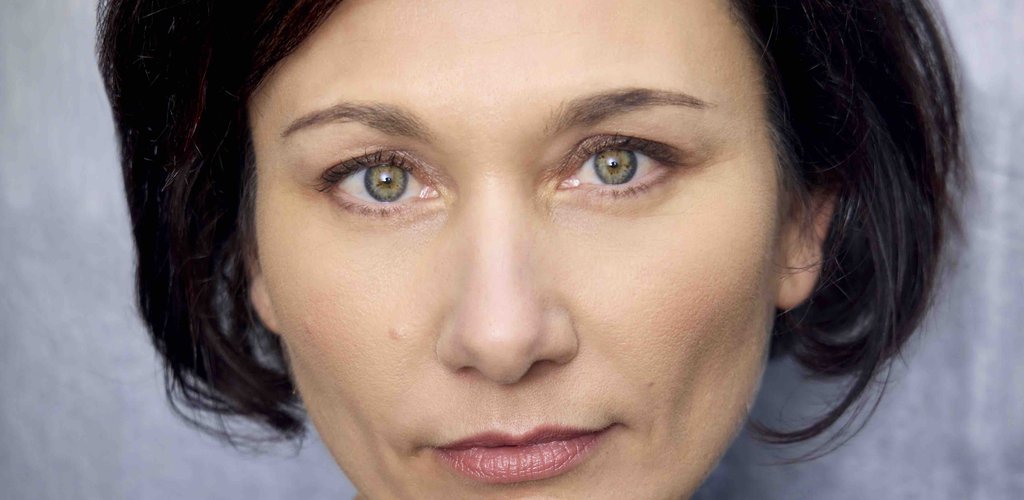Chiara D’Anna is an Italian born award-winning actress, director and commedia dell’Arte specialist who currently lives in London. She is the co-director and choreographer of BFO’s new opera production, Ariadne auf Naxos. Her work includes stage productions, multimedia performances, site-specific immersive work, happenings and commedia dell’arte shows. Chiara works as a freelancer Movement Coach at the Royal Academy of Dramatic Art in London, and teaches commedia dell’arte at the Accademia dell’Arte in Arezzo, Italy. She is best known for her cinematic collaboration with auteur Peter Strickland in The Duke of Burgundy and Berberian Sound Studio.
Júlia Váradi: This is your first time working with Iván Fischer. How did you find one another?
Chiara D'Anna: I believe he found me through intermediaries, and when the question reached me whether I would like to take part in the joint directing of Ariadne auf Naxos, I immediately and enthusiastically said, “Yes.” I was delighted to be asked, in part because of Iván Fischer, but also because it is such an exciting piece. Ariadne auf Naxos is a special opera, but what Iván Fischer and I are working on now is unique. It is based on some extraordinary ideas, and thus requires a rather complex approach. The first scene – the prologue – is produced entirely differently from the later scenes, which is a novelty as far as the commedia dell’arte genre is concerned.
J. V.: Have you ever seen an opera performance directed by Iván Fischer?
Ch. D'A.: Not in person, unfortunately, but I have of course studied the recorded ones, and I find their perspective very interesting. I like that the musicians are performing on stage and become a part of the acting. I love people who experiment, and I really enjoy the way Iván involves everyone in on-stage work, and that everyone has a role to play. This makes the performance very interesting. I also appreciate the way he manages space on stage, using every nook and cranny. This allows the singers and musicians to find their ways to one another during the piece. Even the conductor is part of the great game. This is something I had never encountered before. I like it a lot.
J. V.: As an expert in commedia dell’arte, I understand that you not only use the method, but are also a teacher of the genre. Would you define for us the essence of this popular theatrical performance style?
Ch. D'A.: In a nutshell, I would say the essence is that there is no pre-written text — the actors improvise every time. The performance is built on the so-called “canovaccio” structure, which leads the plot along line by line from beginning to end. The performance is the joint work of the actors participating, and achieves its final form only on stage, following some preparatory conversations. The end result also depends on the reactions of the audience. This opens up a lot of opportunities for the creativity of the actors. The performance genre was born in the 16th century, and is a great reflection of the Italian concept of action on stage. It generally includes actors with and without masks, depending on whether or not they need to sing on stage, in which case a mask in front of their face would be an obstacle for them. Another thing that is very important for commedia dell’arte performances is that the actors use a lot of physicality on stage. There is a lot of movement, gestures and physical strength. The pieces include precisely defined characters and their gestures show who and what they are.
J. V.: What are the types in Ariadne auf Naxos which are typical for the genre of commedia dell’arte?
Ch. D'A.: First, we have the quintessential Harlequin (Arlecchino), then Truffaldin, Harlequin’s partner and his helper. And let’s not forget the wonderful Zerbinetta, who I think is the most beautiful character in the opera. She is an essential element of the commedia dell’arte. Brighella, the first servant, is also on stage, and we have Scaramuccio, who is a “cool captain” overseeing the action.
J. V.: The opera begins with a powerful scene from Strauss’s little known orchestral suite Le bourgeois gentilhomme, which must have been a challenge to integrate with the rest of the opera. How did you manage this?
Ch. D'A.: This is a brilliant addition because in the opening scene, we see the preparations for the theater performance that is to follow. This reveals the essence of commedia dell’arte to the audience and introduces them to the types of characters they will see in Ariadne. I enjoyed this very much as an actress and director, and of course as someone teaching commedia dell’arte. Also it helps make clear that the message Ariadne’s tragedy holds for all of us is that instead of being bitter, we should find joy in our lives, because it is always there, close by.
J. V. : So by now you must have an answer to the question: “What is it like to work with Iván Fischer?”
Ch. D'A.: It is very inspiring, very exciting and also a very valuable challenge. Iván on the job is like the best Harlequin I can imagine.
